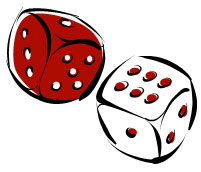

The relationship between multiple events that occur is important. The key question that you need to think about is, “does the first event influence the outcome of the next event?”
For example, consider a pair of number cubes. One cube is red and the other cube is white. Let’s assume that both number cubes are fair cubes; that is, each number on each cube has an equal chance of landing on the top face.
If you roll both cubes, does the number that appears on the top face of the red number cube affect the number that appears on the top face of the white number cube? Why do you think that is the case?
Interactive popup. Assistance may be required. No. The number cubes may bounce off one another, but the number appearing on the top face of the white number cube does not depend on the number that appears on the top face of the red number cube.
Sort the following situations into two categories: situations where the outcome of the second event depends on the outcome of the first event, and situations where the outcome of the second event does not depend on the outcome of the first event.
![]() Drag the tile containing the descriptors into the appropriate column.
Drag the tile containing the descriptors into the appropriate column.
When you have a series of compound events where the outcome of the first event affects the outcomes of the subsequent events, these events are called dependent events. We can say that the outcome of the second event depends on the outcome of the first event.
When you have a series of compound events where the outcome of the first event does not affect the outcomes of the subsequent events, these events are called independent events. We can say that the outcome of the second event is independent of the outcome of the first event.
Determine whether the following events are independent events or dependent events.
Interactive popup. Assistance may be required.
Will the number that appears on the top face of the number cube depend on whether or not the coin lands with heads facing up? Interactive popup. Assistance may be required.
Independent events
Interactive popup. Assistance may be required.
Independent events
Interactive popup. Assistance may be required.
After Herb selects the first package, are there still 12 packages to choose from when selecting the second package?
Interactive popup. Assistance may be required.
Dependent events
Interactive popup. Assistance may be required.
Does Shirley have the same number of packages from which to select for the second draw as the first draw?
Interactive popup. Assistance may be required.
Independent events
Interactive popup. Assistance may be required.
After Mrs. Siddiqi selects the first computer, are there still 20 computers on the assembly line?
Interactive popup. Assistance may be required.
Dependent events